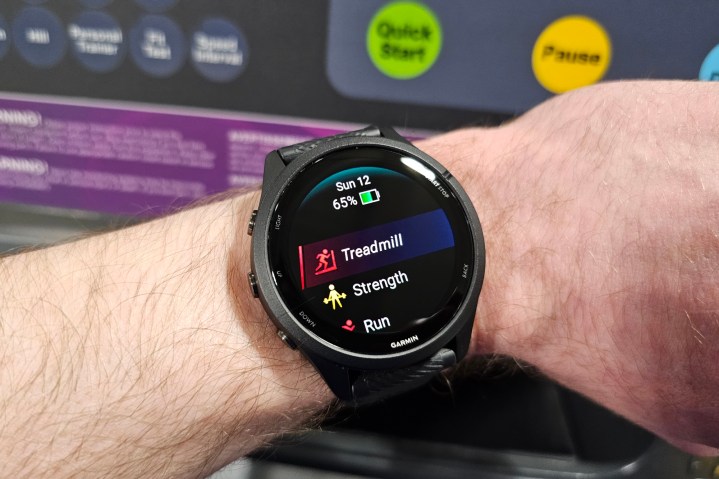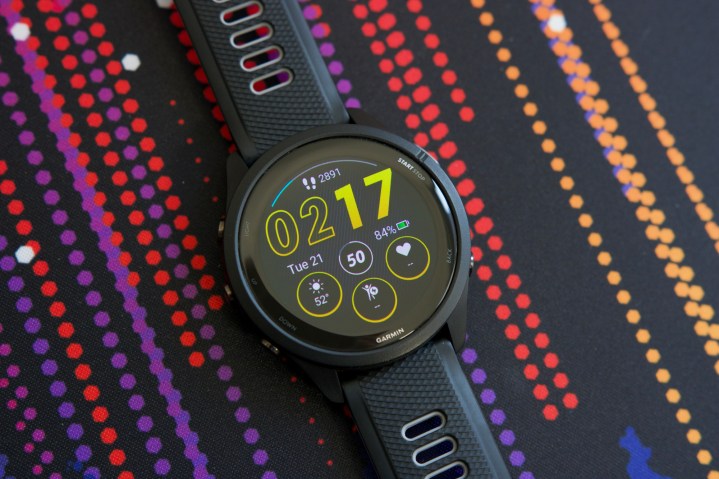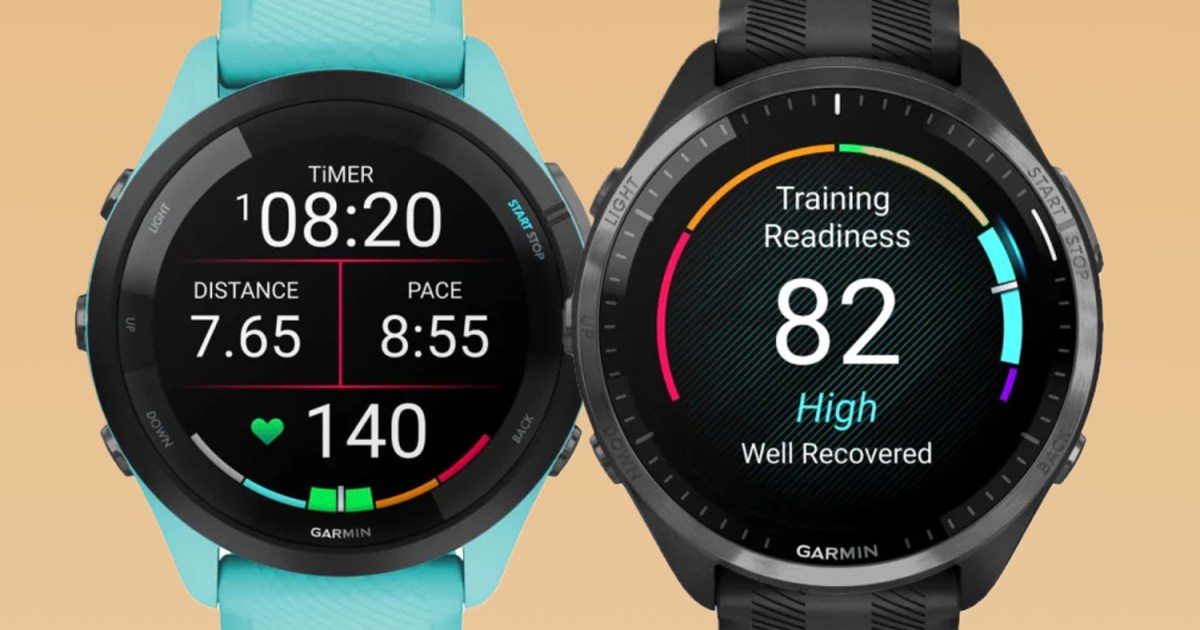Garmin has been a dominant player in GPS-enabled sports watches, and the Forerunner series has gained immense popularity among athletes and fitness enthusiasts worldwide. The series boasts diverse features and functions that cater to users’ varying needs, with the Garmin Forerunner 265 and Forerunner 965 standing out as two of its most notable models.
The Garmin Forerunner 265, one of the best fitness trackers on the market, is a reliable and user-friendly watch with features designed to help runners and others track their progress and improve their performance. On the other hand, the Garmin Forerunner 965 is a premium GPS watch that takes things to the next level. With advanced features, the watch offers unparalleled accuracy and reliability.
Which Garmin Forerunner is the one for you almost certainly depends on what you plan on using it for — and what you’re willing to spend.
Garmin Forerunner 265 vs. Forerunner 965: specs
| Garmin Forerunner 265 | Garmin Forerunner 965 | |
| Size | 46mm | 47mm |
| Display | 32.5mm display size
AMOLED (optional always-on mode) Corning Gorilla Glass 3 416 x 416 pixels |
35.4mm display size
AMOLED (optional always-on mode) Corning Gorilla Glass 3 454 x 454 pixels
|
| Bezel materials | Fiber-reinforced polymer | Titanium |
| Media storage | 8GB capacity | 32GB capacity |
| Color choices/combinations | Six available | Six available |
| Battery | Up to 15 days
Rechargeable lithium-ion battery |
Up to 23 days
Rechargeable lithium-ion battery |
| Dimensions and weight |
46.1 x 46.1 x 12.9 (mm), 47 grams |
47.2 x 47.2 x 13.2 (mm), 53 grams |
| Sensors | GPS
GNSS Galileo Satiq technology Heart Rate Monitor Blood Oxygen Saturation Monitor Barometric Altimeter Compass Gyroscope Accelerometer Thermometer Ambient Light Sensor |
GPS
GNSS Galileo Satiq technology Heart Rate Monitor Blood Oxygen Saturation Monitor Barometric Altimeter Compass Gyroscope Accelerometer Thermometer Ambient Light Sensor |
| Connectivity | WiFi, Bluetooth, ANT+, multi-band and dual-frequency GNSS | WiFi, Bluetooth, ANT+, multi-band and dual-frequency GNSS |
| Water rating | 5 ATM | 5 ATM |
| Price | $450 | From $600 |
Garmin Forerunner 265 vs. Forerunner 965: design

If you’re looking for a stylish and reliable wearable, the Forerunner 265 and 965 are great options. The Forerunner 265 boasts a sleek design that measures 46mm and comes in six different color combinations, so you can pick the one that suits your style best. Its bezel is made of a fiber-reinforced polymer, and it also features a quick-release silicone band that makes it easy to put on and take off.
The Forerunner 965 is a step up in terms of quality and materials. It’s available in a slightly larger size of 47mm, and its bezel is made of titanium, which looks beautiful and ensures durability and longevity. The quick-release silicone band on this model is just as convenient as on the Forerunner 265, making it a breeze to switch up your look whenever you like.
Garmin Forerunner 265 vs. Forerunner 965: display

The stunning displays stand out on both of these watches. The Forerunner 265 boasts a 32.5mm AMOLED display with a pixel resolution of 416 x 416. The display is colorful and made of Corning Gorilla Glass 3 for extra durability, which means it can withstand accidental drops and scratches without damage.
The Forerunner 965 takes it up a notch with a 35.4mm display made of the same Corning Gorilla Glass 3 for protection. The pixel resolution of 454 x 454 makes it even sharper and more vibrant, allowing you to read your stats and notifications in bright sunlight.
Both displays are touchscreens, so you can easily navigate the menus and apps with a simple swipe or tap.
Garmin Forerunner 265 vs. Forerunner 965: internal hardware

The Forerunner 265 comes with 8GB of onboard memory, making it ideal for runners who prefer to listen to music during their workouts. This amount of storage provides ample space for a reasonable number of songs to be added to the watch.
The Forerunner 965 takes things up a notch with a massive 32GB of storage. This is four times the amount of storage provided by the Forerunner 265, which means you can store all your favorite songs and still have plenty of space for critical data such as running metrics and other fitness-related information.
The Forerunner 265 and Forerunner 965 use proprietary chipsets, which means they are designed to work seamlessly with Garmin’s ecosystem of fitness and health apps.
Garmin Forerunner 265 vs. Forerunner 965: battery life

Garmin is known for its exceptional battery life transparency on its wearable devices, providing users with detailed information on how long they can expect their device to last on a single charge. As expected, the more premium Forerunner 965 boasts better battery specs than the Forerunner 265.
If you plan on using the Forerunner 265 as a smartwatch only, you can expect up to 13 days of battery life before recharging. However, when using the GPS or GNSS receiver, battery life can drop significantly to as low as six hours.
The Forerunner 965 offers an impressive battery life of up to 23 days as an everyday smartwatch. However, if you use the navigation feature continuously, the battery life can drop to about 8.5 hours between charging is needed.
Garmin Forerunner 265 vs. Forerunner 965: health and fitness

Both watches offer advanced training capabilities that make them stand out. For starters, both watches feature adaptive training plans to help you prepare for your next big race. These plans are tailored to your fitness level and goals and adjust as you progress, so you’re always working toward your next milestone. Both watches also offer daily suggested workouts to help you stay on track and keep your training varied and exciting.
Another feature that sets these watches apart is their heart rate variability status. This feature gives you an in-depth look at how your body responds to your workouts and can help you adjust your training plan as needed. Additionally, both watches offer training readiness scores that consider factors like sleep quality, recovery, and training load. With this information, you’ll always know when it’s time to push yourself and when it’s time to give your body a break.

But if you love to explore new routes and trails, the Forerunner 965 is the watch for you. This watch offers turn-by-turn directions and detailed maps of streets, trails, and other map features, so you’ll never get lost on your runs again. The Forerunner 965 also offers advanced training features like Load Ratio, Chronic Load, and Acute Load, which can help you fine-tune your workouts and get the most out of every session.
Both watches are also great for tracking other types of physical activity, from gym workouts to hiking, swimming, and more. With the ability to track heart rate, blood oxygen saturation, and sleep, you’ll always have a complete picture of your health and fitness.
Garmin Forerunner 265 vs. Forerunner 965: price and availability

The Forerunner 265 costs $450. If you prefer a smaller size, the 42mm Forerunner 265S offers the same features at the same price.
The Forerunner 965 is priced at $600. If you spend an extra $100, you can get the HRM-Pro Plus heart rate monitor on your watch. Both models are available in six different color combinations.
Garmin Forerunner 265 vs. Forerunner 965: Which should you buy?

There is a difference in the price of $150 between the two models of Garmin Forerunner watches. The Forerunner 965 is the more expensive model. It has a larger display, is made of titanium, offers more advanced training features, and has a longer battery life. On the other hand, the Forerunner 265 is a little bit lighter, is made from a polymer material, and has less onboard storage and battery life, as well as fewer training features.
If size and cost are not the primary factors, consider the Forerunner 965, which offers more advanced features. If you are on a budget, the Forerunner 265 is an excellent option for everyday runners and anyone looking for a watch that tracks key health and wellness metrics.
Ultimately, you can’t go wrong either way; you should just buy the watch that lines up with your needs the best.
Editors’ Recommendations







